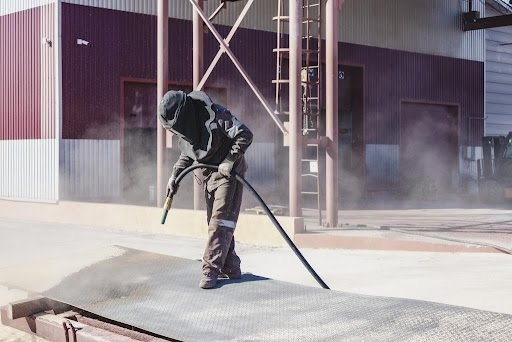“Unlock the secrets of sandblasting 🚀 Dive in our comprehensive guide to understand its process and uses 🧑🔧 Don’t miss out! 💡”
Sandblasting, also known as abrasive blasting, is a technique that involves propelling abrasive particles at high speeds onto a surface using compressed air. This process effectively cleans, smooths, or prepares materials such as painting or coating for further treatment. It’s a vital method in various industries, from construction to automotive, where surface integrity is crucial.
Sandblasting
It was first developed to clean surfaces, particularly for industrial applications. What is sandblasting? The technique has evolved over the years, adapting to technological advancements and the diverse needs of different industries. Today, sandblasting is recognized for its efficiency and versatility, making it an essential tool in modern manufacturing and restoration projects.
How Sandblasting Works
The sandblasting process typically involves several key components:
Compressor: This is the heart of the operation, generating the high-pressure air needed to propel the abrasive particles.
Blast Hose: This hose carries the compressed air and abrasive media from the compressor to the nozzle.
Nozzle: The nozzle directs the flow of air and media onto the target surface. Different nozzle sizes and shapes can affect the precision and speed of the blasting process.
Abrasive Media: Various abrasive materials can be used, including sand, glass beads, steel grit, and more. The choice of media depends on the specific application and the surface being treated.
Protective Gear: Safety equipment protects operators from harmful dust and debris. This includes respirators, goggles, gloves, and protective clothing.
Types of Sandblasting
There are several methods of sandblasting, each suited to different applications and environments. Understanding these types will help you choose the right approach for your project.
1. Wet Sandblasting
Wet sandblasting, or slurry blasting, involves mixing water with the abrasive media. This method is particularly effective for:
Dust Control: The water helps suppress dust, improving visibility and air quality.
Surface Preparation: Wet sandblasting can provide a more uniform finish, making it ideal for preparing surfaces for painting or coating.
Reduced Health Risks: By minimizing airborne particles, this method lowers the risk of respiratory issues for workers.
Wet sandblasting is commonly used in graffiti removal, paint stripping, and cleaning delicate surfaces.
2. Dry Sandblasting
Dry sandblasting is a traditional technique widely used for various industrial applications. Some advantages include:
Speed: This method can be quicker, making it suitable for high-volume projects.
Versatility: It works well on various materials, including metal, wood, and masonry.
However, dry sandblasting generates more dust, requiring stricter safety precautions and ventilation to protect operators from harmful exposure.
Choosing the Right Sandblasting Media
Selecting the appropriate sandblasting media is crucial for achieving the desired results. Here are some factors to consider:
Material Hardness: Choose a media that matches the hardness of the surface you’re treating. For more complex materials, use harsher abrasives, while softer materials may require gentler options.
Media Size: The size of the abrasive particles can impact the finish. Finer particles create smoother surfaces, while coarser media is better for aggressive cleaning.
Shape: The shape of the media can affect how it interacts with the surface. For example, angular particles can effectively cut through rust, while round particles provide a gentler finish.
Common types of sandblasting media include:
Silica Sand: Traditional and cost-effective, but it poses health risks if inhaled.
Glass Beads: Great for achieving a smooth finish with minimal dust.
Steel Grit: Excellent for heavy-duty applications and removing tough coatings.
Baking Soda: A non-toxic option for delicate surfaces, such as cleaning artwork or historic buildings.
Common Uses of Sandblasting
Sandblasting is employed in a wide range of applications across various industries, including:
Metalworking: Used for cleaning rust, paint, or scale-off metal surfaces before coating or painting.
Construction: Essential for preparing concrete and masonry surfaces for finishing.
Automotive: Applied for restoring old vehicles by removing layers of paint and corrosion.
Restoration Projects: Ideal for cleaning stone, brick, and other materials in historical restoration.
Understanding these applications can help you identify when and how to use sandblasting effectively.
Sandblasting Safety: What You Need to Know
Safety should always be a top priority when engaging in sandblasting. Here are essential safety measures:
Key Protective Equipment
When sandblasting, wearing the right protective gear is crucial. Essential safety equipment includes:
Respirators or Masks: To filter out harmful dust and airborne particles.
Goggles: To protect your eyes from flying debris.
Hearing Protection: Sandblasting equipment can be loud, so earplugs or earmuffs are necessary.
Gloves: Heavy-duty gloves protect your hands from abrasives and sharp edges.
Durable Clothing: Wear long sleeves and pants made from sturdy materials to guard against cuts and abrasions.
Best Practices for Safe Sandblasting
Following safe sandblasting practices is vital for preventing accidents and ensuring worker well-being. Here are some best practices to keep in mind:
Proper Ventilation: Always work in a well-ventilated area to reduce the accumulation of dust and harmful fumes.
Regular Equipment Maintenance: Ensure that all equipment is in good working condition. Regular inspections can help identify potential issues before they lead to accidents.
Training: Provide thorough training for all workers involved in sandblasting. Understanding the equipment and safety protocols is essential for preventing injuries.
Follow Regulations: Adhere to local health and safety regulations regarding sandblasting. This may include specific requirements for dust control, noise levels, and protective gear.
Emergency Procedures: Establish a clear plan for emergencies and ensure that all workers are aware of the procedures in case of accidents or health issues.
Conclusion
Now that you have a deeper understanding of sandblasting, its processes, and its applications, you can confidently tackle your next project. Whether cleaning, preparing, or restoring surfaces, mastering the art of sandblasting can lead to professional results. Always prioritize safety and choose the correct methods and materials for optimal results.

